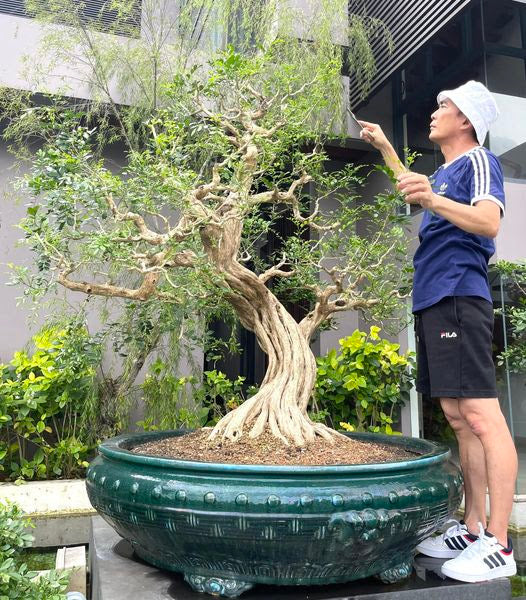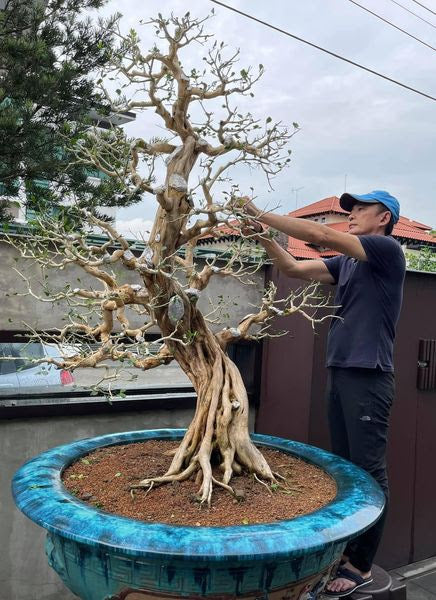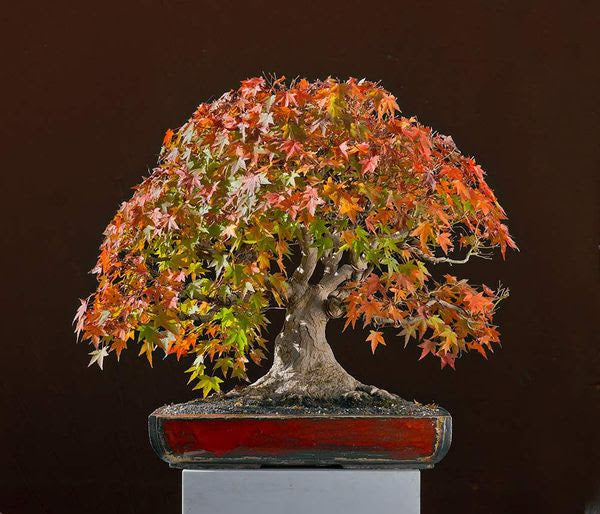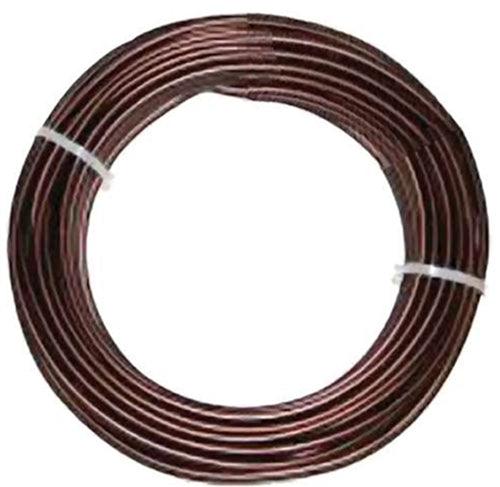Monster Trees

Here's a rather impressive multi-tree Siberian elm. I count 31 trunks.
Today we've got some monster and less than monster penjing from a site called LingNan PenJing. Penjing is bonsai that is commonly found in China and Southeast Asia (especially in Vietnam where bonsai is everywhere). It is not nearly as popular in North America and much of the West, where most bonsai are influenced by the Japanese tradition. Still, the best of penjing is spectacular, though it might take some getting used to.

Just in case you think we're exaggerating when we say monster Penjing.

Still a penjing, but a little closer to Japanese influenced styling.

This type tray is common in penjng forests and other landscape plantings. There are no drain holes by the way. This does not present a drainage problem if you know what you're doing.

This type tree-rock combination is fairly common in penjing. Little human and other figurines are also common in penjing. This one works to perfection by instantly creating the illusion size and space.

If this were in Japan I think it might qualify as bunjin (though the trunk is a little heavy). In China they are called Literati (Wenjen). This term comes from caligraphy and dates back at least to Han Shan and the old Cold Mountain masters.

One more 'monster' shot from LingNan PenJing
Favorites

Bonsai perfection. Kumquat bonsai are often shohin, though this one appears a little larger (no dimensions are given). Luis Vallejo provides the following information with this tree: Fortunella hindsii Kumquat, By Nobuichi Urushibata, Taishoen. Luis Vallejo Bonsai Garden, Photo Miguel Krause. Taishoen is Nobuichi's bonsai nursery in Japan.
Luis is an accomplished bonsai artist and the owner of Museo de Bonsai Acalanes in Spain. Fortunella hindsii Kumquat, is of course the type tree, with the Fortunalla hindsii being the smallest of the Kumquats.
Today we've got some favorites from our very own facebook page for you. Stay tuned for more as this year approaches its grand finale.

This is a Japanese white pine, aka Japanese five needle pine, Goyomatsu, Pinus parviflora. Masahiko Kimura (The Magician) is the artist.

This Japanese maple is from the Omiya Bonsai Art Museum in Saitama, Japan.

Nice pine with a dramatic exposed root and well aged bark. It's from Hong Kong Bonsai Pots. No variety is mentioned.

This one is a Rocky mountain juniper by Todd Schlafer. We love finding trees that have been worked on by multiple artists and students. Here's Todd's comment with this one: Recently worked on by Ralph Padilla, then @tommylee and I worked on it during his recent visit.

Another great Rocky mountain juniper by Todd Schlafer. Todd is a rising star in our bonsai world and has become a regular here at Stone Lantern since we discovered him a few years ago.
In Todd's words: I wasn’t sure exactly how this tree would look when we started designing it, but I knew it was going to be special. I love how this tree turned out with the collaboration and input from students.

Pure joy in tree form. This is, of course, a Japanese maple by the inimitable Walter Pall.

Finest Tropical Bonsai from the 5th U.S. National Bonsai Exposition. The tree is a Tiger bark Ficus (Ficus microcarpa) by Hoe Chuah. Photo taken by Oscer Jonker of Bonsai Empire.

This Japanese white pine was posted by Bjorn Bjorholm (Eisei-en Bonsai). From the artist: Field-grown in Japan and imported to the U.S, this chuuhin-size JWP is grown on its own roots and possesses soft, feminine foliage, characteristic of the species.

Here's a famous Kimura planting that has spawned numerous copycats. The trees are Hinoki cypress (Chamaecyparis obtusa).
Unique Bonsai Motor World

Here's a monster Taxus (Yew) by Mariusz Komsta aka Bonsaimotorworld. The trees below are his as well.

Nice scroll too.

I don't think I've ever seen a formal upright Trident maple. Until now at least.

Ramification!

I think it only snows occasionally at Bonsaimotorworld.

Looks like a Trident maple. Mariusz's caption: Ichi go ichi e - This year quite different colors .. FOR SALE. Ichi-go ichi-e is an old Japanese proverb that means one opportunity, one encounter.

By the way, Mariusz is in the process of selling his nursery. Or at least all the trees and everything else he offers. In that light, here's his caption: Still many trees 🌲… if you are happy to visit and buy whatever tree you like , garden tables and pots ( accent, bonsai and prebonsai ), lanterns , kake and complements you are welcome.

Nice studio. Here's Mariusz's caption: I know what to do with myself ... do Bonsai and pluck needles.
Remarkable Bonsai

Here's a root-over-rock Trident maple by David Benavente that's for sale. His caption reads: 🍁 Autumn is certainly a special time to enjoy maple trees. This rock-grabbed burgerianum is one of the delights of many garden visitors.

This remarkable wild and wonderfully expressive tree was posted by our friend Michael Hagedorn (Crataegus Bonsai) at the recent Pacific Bonsai Expo. Michael is the author of Bonsai Heresy, the book that 'took and shook' our whole world and Post Dated, long my favorite bonsai read. As is the case in photos shot at expos, trype of tree and owner usually remain a mystery. I guess you'll have to wait for Jonas Dupuich's upcoming show album.

I suppose this one is not exactly a bonsai but it's not that far from our art. It was posted by Ancient Forests and Champion Trees. Here's the caption: 800 Year Old Oak Tree! It is called Majesty, or the Fredville Oak, and is located in Fredville Park, Nonington, Kent.

I found this Hinoki cypress at Bonsai Empire. It's originally from Bonsai Harmony — at 藤川光華園 in Ikeda Osaka, Japan.

This massive Douglas fir appears on both Walter Pall and Mauro Stemberger's timelines. Here's the caption: Let’s start the US tour in Chicago with this beautiful Douglas Fir from my friend Dan Turner collection At Hidden Gardens.
Larch Season

Mauro Stemberger calls this European Larch (Larix decidua) Autumn Gold. It's part of his ItalianBonsaiDream collection.
Today we've got some larches for you. We live at the southern reaches of their range here in Northern Vermont where then tend to turn about three weeks after the maples, oaks and all the rest. So for the last couple weeks they have been putting on a magnificent yellow to gold grand fall finale for our enjoyment. Gratis too!

Here's another European larch after all the autumn gold is gone. Turns out that it too was once part of the Mauro's Italian Bonsai Dream collection. It now belongs to Walter Pall.

The Guardian of Laments is Giacomo Pappalardo's name for this magnificent old European larch (Larix decidua).

Lots of action in the old trunk.

A well developed apex makes for an impressive tree.

It would be remiss to feature larches and not mention Nick. This one is another American Larch (aka Tamarack) by Larch Master Nick Lenz. The photo is from the 6th U.S. National Bonsai Exhibition

Here's an American larch originally by Nick Lenz that lives at the Pacific Bonsai Museum.

When I first glimpsed this photo, I though maybe it was a painting. In addition to being a great bonsai, it's a good example of what early fall color looks like on a Larch. Also a good example of what larch cones look like. I'll take a not-so-wild guess that it was collected somewhere in Europe. Which would make it a European larch (Larix decidua). The photo is from the National Exhibition in Switzerland (Mostra Nazionale Svizzera 2016). The artist is Nicola Kitora Crivelli.
The Bonsai of Pedro Morales

Sweet tree, sweet pot. Pedro Morales says that it's a shohin size bonsai from his cousin Carlos C. Morales. The pot is Japanese. Glen Lord suggested that the tree is a type of Ixora. For those of you who don’t know Pedro Morales, he’s a well known bonsai artist, teacher and author from Puerto Rico. All of today's trees are his.

I like this Nea buxifolia's natural feel and smooth clean lines, which are echoed by the smooth simple lines of the pot. BTW: if you're having trouble finding it, Nea is sometimes spelled Neea.

This Nea groove reflects a natural growth pattern, with the oldest trees near the center and the smaller younger trees leaning out for light.

While we're showing Nea... I don't know if this is also a buxifolia, or another species (a quick web search didn't turn any other Nea species up, but the emphasis is on quick).

Another simple, clean tree in a smooth clean pot. This one is an Astromelia.
Reel Bonsai

Today we've got some outstanding bonsai from Matt Reel. Matt returned to the States from Japan in 2014 after a staggering 8 years apprenticeship with Shinji Suzuki. Matt set up shop in Portland, OR to start his professional career. We hope you don't mind the lack of captions, the trees stand on their own.






Hagedorn Hemlock, And Others

I could probably say something, but maybe it's best to quote the artist, Michael Hagedorn by the way, and leave it at that: Mountain Hemlock after its yearly trim. This is a big one—5’6”, taking 2-4 people with poles and straps to lift. Visit it at the Portland Japanese Garden, in the hidden terrace up the stairs of the main building…like many things there, it’s like a treasure hunt. Full story on my blog; link on my profile.

i picked up today's photos off Michael's FB timeline. There's no caption with this one so we'll leave it that way.

Michael's caption: Climbing Hydrangea, an unusual vine for bonsai. This one was grown from a cutting since 1962. It’s fun (and an honor) to have it in the garden.
 A shot from Michael's bonsai garden.
A shot from Michael's bonsai garden.
 Another one.
Another one.

Michael has a thing about companion plants (aka accent plants). Though when they stand alone you wouldn't really call them companions. The Japanese call them kusamono. Here's quote from Young Choe, a master of the art: The name is composed of two Japanese characters-- “grass” and “thing”—which together suggest humble, everyday plants.

Impressive planting. Looks like some kind of Horsetail fern.

I know for a fact that Michael has a soft spot for Chojubai quince. I think many Japanese share that soft spot, so Michael may have picked it up when he apprenticed in Japan.

Pine bark and needles close up. Looks like a two needle type pine. Probably a Japanese black or maybe a Japanese red.

Satuski azaleas at the famous Portland (Oregon) Japanese garden. I don't know if you would call Michael the curator of the bonsai there, but I believe that he the main person responsible for maintaining their beauty and well being.
Classics From The Omiya Bonsai Art Museum

No caption from The Omiya Bonsai Art Museum for this or any of today's other trees, though it does resemble so many Japanese maples we've seen over the years.

Same with this one.

Multi trunked Satsuki. This one is all about the flowers.

Interesting pot color. Would you have chosen it?

A Satsuki in bloom. If you look closely, you can just make out how massive the trunk is.

Much of this tree's trunk was originally roots.

Another one that looks suspiciously like a Japanese maple.

Here it is again.

And again!
45th Gafu Ten Shohin Bonsai Exhibition

Bill Valavanis took this and the rest of today's photos at the 45th Gafu Ten Shohin Bonsai Exhibition. Bill is a very busy man who provides an endless stream of some of the world's best bonsai. Because it's impossible for him to do everything, some photos are without captions, including this one. So we'll leave it at that.

Between the flowers, the bark, and the pot there's a lot going on here.

A lot of trees Bill shot feature brilliant berries and fruit.

Stunning colors! Judging by the flowers I'm pretty sure it's a quince.

You don't see that many Westerners exhibiting in major Japanese shows, but inroads are being made. Roy Minarai lives and works in South Carolina.

It takes a strong tree to hold its own in such a brilliant pot.

I think you'd be safe guessing Japanese white pine for this one. By the way, Bill and many others refer to them as Japanese five needle pines, which is a translation of the the Japanese name Goyomatsu. And they do, after all, have five needles per bundle (fascile).

There's another one of these little lovelies above. My best guess is that both are dwarf Kumquats.

